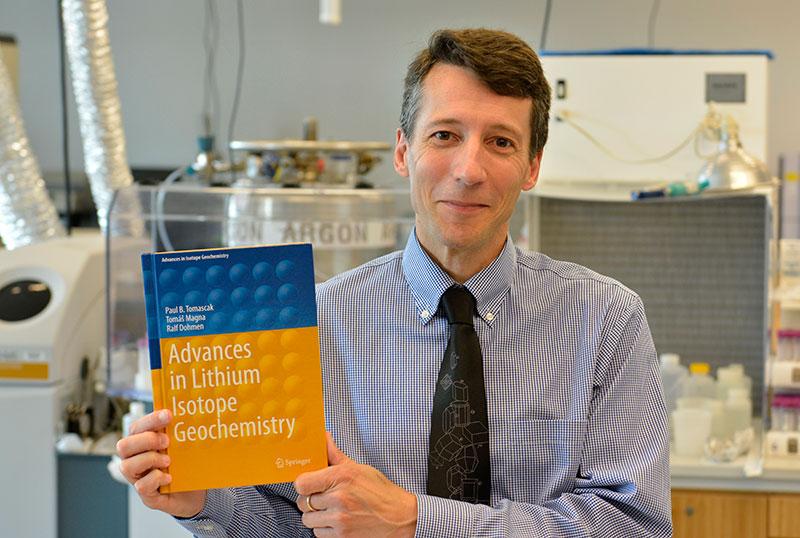Scientific advances—In the new book “Advances in Lithium Isotope Geochemistry,” Paul Tomascak of SUNY Oswego’s atmospheric and geological sciences faculty assembles and summarizes, as lead author, all the research in a booming field that has applications from star formation to sources of groundwater pollution.
Lead author Paul Tomascak of SUNY Oswego’s atmospheric and geological sciences faculty pulls together in a new book all of the modern research on the element lithium’s isotopes, a booming field of study with applications from exploring star formation to tracing sources of groundwater contamination.
Paul Tomascak with bookIn the comprehensive book titled “Advances in Lithium Isotope Geochemistry” from Springer, global publishers for scientific and other professional communities, Tomascak and co-authors Tomáš Magna and Ralf Dohmen summarize an explosion of research from 2004 to 2015.
The project grew from a chapter Tomascak contributed to a 2004 book on research in the field. Springer approached him to write a full book version.
“I think the main value of this is for the scientist who’s just trying to get into a new field,” said Tomascak, who also serves as the college’s associate dean of liberal arts and sciences. “You can go and read a couple of papers and you’ll wonder, ‘Am I missing something crucial?’ Up to some time in 2015, this book has everything there was” on lithium isotope research.
Lithium, known popularly for its use in batteries, pharmaceuticals, detergents and ceramics, has two naturally occurring isotopes, which are forms of an element with equal numbers of protons but different numbers of neutrons in their nuclei. Measuring differences in the presence of lithium isotopes has far-ranging applications—as far as the reaches of the cosmos, Tomascak said.
“Astrophysical processes cause the ratio of the light lithium isotope to the heavy isotope to be different,” Tomascak said. “These are measurements we can make observationally at great distances. These are capable of putting a fingerprint on a process, a really big-scale stellar process.”
Wide application
Closer to home, he said, this fingerprinting characteristic can be used to study groundwater movement and contamination. Tomascak said that after a synthetically enriched form of a lithium isotope was used in the manufacture of thermonuclear weapons in the 1940s and ‘50s, stockpiles of the depleted substance were sold cheaply to industry for the extraction and use of lithium for a wide range of peaceful purposes. Presence of the engineered lithium isotope in water can be used to trace the source of pollution, he said.
“There’s interest in the book across broad fields,” said Tomascak, who teaches courses in geology and geochemistry. “The medical people have some interest in lithium isotopes, environmental people certainly have interest.”
Tomascak started experiments in lithium after completing most of the lab work for his dissertation at University of Maryland in 1994. He wrote a paper five years later about his work, the first to use a new style of mass spectrometer to measure lithium isotopes. “Pretty much everyone in the world now who measures lithium isotopes uses some modification of that procedure,” he said. The difference today is that the technology is more readily available and constantly improving.
The professor frequently is called on to review manuscripts in the field for journals and funding agencies, which is how he came to know the book’s co-authors, both “very productive early-career scientists.” Magna works with the Czech Geological Survey, while Dohmen specializes in experimental and theoretical petrology at Ruhr University Bochum in Germany.
“Advances in Lithium Isotope Geochemistry” is available through many online book retailers or directly from Springer.




